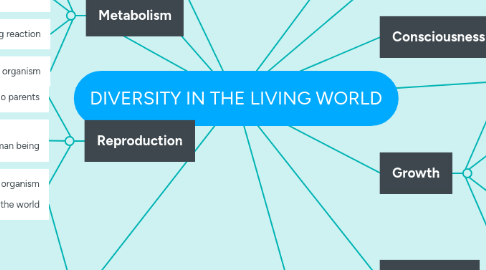
1. Reproduction
1.1. Production of progeny posessing features similar to parents
1.2. Organisms doesn't reproduce Eg. Mules, sterile worker bees, infertile human being
1.3. Not a defining characteristics of living organism
2. Metabolism
2.1. Sum of all chemical reaction occurring in our body is metabolism
2.2. No non living organism exhibit metabolism
2.3. Isolated metabolic reaction in in vitro are nit living things but living reaction
2.4. Cellular organisation is defining property of living organism
3. Nomenclature
3.1. A particular organism is known by the same name all over the world
3.2. Universal rules
3.2.1. Names are written in Latin and written in italics
3.2.2. First word-genus Second word-specific epithet
3.2.3. Biological names underlined when handwritten or printed in italics
3.2.4. Genus starts with caps letter Specific epithet starts with small letter
4. Taxonomy
4.1. The process of classification of all living organisms into different taxa.
5. Taxonomic categories
5.1. Species
5.1.1. Studies consider a group of individual organism and their fundamental similarities
5.1.2. Distinct morphological differencrs
5.2. Genus
5.2.1. A group of related species which has more characters in common in comparison to the species of other genera
5.3. Family
5.3.1. A group of related genera with still less no of similarities compared to genus and species
5.4. Order
5.4.1. Few similar charecters
5.5. Class
5.5.1. It includes related orders
5.6. Phylum
5.6.1. In plants it is called division
5.7. Kingdom
6. Growth
6.1. Twin characters -growth in mass and number
6.2. Non living organisms can grow -boulders &rocks
6.3. Not a defining characters of living organism
6.4. Growth and Reproduction are mutually exclusive events
7. Consciousness
7.1. Consciousness is the defining property of living organism
8. Biodiversity
8.1. The no and type of organisms present on earth
8.2. Described range 1.7-1.8 million
9. Binomial nomenclature
9.1. Two components Generic name Specific epithet
10. Systematics
10.1. Study of organisms and their diversities and also relationship among them
10.2. Systema-systematic arrangements of organisms
11. Taxonomical aids
11.1. Herbarium
11.1.1. Store collected plant specimens(dried, pressed, preserved on sheets)
11.1.2. It become a store house or repository for future use
11.1.3. Label-date and place of collection, English, local and botanical names, family, collectors name
11.2. Botanical garden
11.2.1. Living plants for references
11.2.2. Labelled-its botanical/scientific name and it's family
11.3. Museum
11.3.1. Set up in educational institutions
11.3.2. Insects-collecting, killing and pinning
11.3.3. Animals are stuffed and preserved and collection of specimens
11.4. Zoological park
11.4.1. Animals are kept in human care
11.5. Key
11.5.1. Used for identification of plants and animals based on similarities and dissimilarities
11.5.2. Based on contrasting characters generally in pair called couplet
11.5.3. Results in acceptance of one and rejection of other
11.5.4. Each statement in key is called lead
11.5.5. Analytical in nature
11.6. Flora
11.6.1. Actually account of habitat and distribution of plants of given area
11.7. Manuals
11.7.1. Information for identification of names of species found in an area
11.8. Monographs
11.8.1. Information on any one taxon
